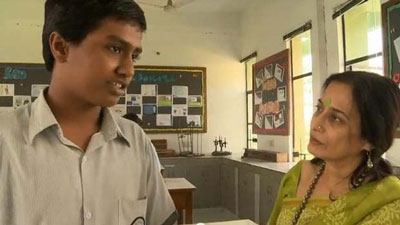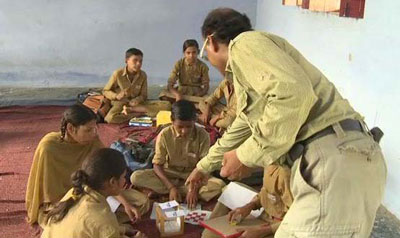1 Formative and summative assessment
There are two types of assessment that are considered distinct from each other because they are used in different ways and for different purposes. You will be very familiar with summative assessment from your own educational experience, but may not have fully explored the value and opportunity in formative assessment – or maybe you are doing it already but were not fully aware of your skill.
- Formative assessment is also referred to by many as ‘assessment for learning’. The major purpose of this type of assessment is to enable students to be given constructive feedback that will help them to learn better and to make effective progress. Such feedback is usually (but not always) given by teachers.
- Summative assessment is also known as ‘assessment of learning’. The purpose of this type of assessment is to enable the teacher to identify the achievement and performance of students at the end of a period of learning, which may be a term or year.
Figure 1 Discussing gaps in student learning.
Summative assessment is usually used to compare one student against others, whereas formative assessment is used to progress learning.
Formative assessment creates a pathway for the student to move on and progress in their learning. It can identify:
- what the student can do and cannot do
- what the students find difficult
- any gaps and misunderstandings the student might have.
It involves:
- dialogue with the student, discussing clear learning goals
- the student being active in achieving their goal
- monitoring of progress, including self- and peer-review.
Timely and useful feedback is part of the process because it helps the student to improve. It is also important that both students and the teacher show persistence until the student achieves their goal, which will almost certainly involve adjustments by the teacher to their teaching to match the student’s needs.
So, formative assessment has a very different purpose and approach from summative assessment, which is more formal. Formative assessment happens in the context of the classroom and builds on the relationship between teacher and student. The main features of formative assessment (Central Board of Secondary Education, 2009) are that it:
- is diagnostic and remedial
- makes provision for effective feedback
- provides a platform for the active involvement of students in their own learning
- enables teachers to adjust teaching to take account of the results of assessment
- recognises the profound influence that assessment has on the motivation and self-esteem of students, both of which are crucial influences on learning
- recognises the need for students to be able to assess themselves and understand how to improve
- builds on students' prior knowledge and experience in designing what is taught
- incorporates varied learning styles into deciding how and what to teach
- encourages students to understand the criteria that will be used to judge their work
- offers an opportunity to students to improve their work after feedback
- helps students to support their peers, and expect to be supported by them.
Formative assessment allows the teacher to build on from where the student is and allows the student to understand what they have to do in order to be successful. Therefore, formative assessment involves the learner and allows the student ownership of their learning.
Continuous and comprehensive evaluation (CCE) is described (Central Board of Secondary Education, 2009) as follows:
The major emphasis of CCE is on the continuous growth of students ensuring their intellectual, emotional, physical, cultural and social development and therefore will not be merely limited to assessment of learner's scholastic attainments. It uses assessment as a means of motivating learners […] to provide information for arranging feedback and follow up work to improve upon the learning in the classroom and to present a comprehensive picture of a learner’s profile.
Activity 1 asks you to think about the differences between formative and summative assessment in a school setting. It is an activity that you could use to start a discussion with your teachers about formative and summative assessment.
Activity 1: Identifying formative and summative assessment
Below is a list of assessment opportunities that can be used in the classrooms in your school. Use your Learning Diary to make two columns, one for formative assessment and one for summative assessment. Now put the assessments from the following list in either column. You may find some could go in either column, depending on the context – for example, singing a song could be summative if it was part of a music exam or formative if it was in preparation for a school performance.
This is an activity that you could do alone, or you may want to broaden it to include others as part of a group activity.
- Pen and paper test
- Recollection from memory
- Hypothesising and performing an experiment in science
- Open book test
- Teacher observation of student
- Cooking to a recipe
- Essays
- Oral responses to questions
- Demonstration
- Performing a song that the student has composed
- Setting a personal best in an athletics race
- Scripting and enacting a play
Discussion
Some of the tasks can be easily identified as providing formative opportunities, such as Option 8, where oral responses allow immediate feedback and discussion. Others would provide summative information, such as the pen and paper test in Option 1, which would lead to a final grade.
However, without further information about the purpose and nature of the assessment, the vast majority are difficult to categorise. For example, a pen and paper test could be used formatively if the results were the start of a discussion with the student about misunderstandings that they may have. Likewise, oral responses to closed questions may result in a ‘score’ that is solely for the teacher’s benefit, in which case they are being used summatively.
Using assessment formatively
You will find it helpful to read Resource 1, ‘Assessing progress and performance’. You might find it useful to share this with your teachers when you open up discussions about the role and style of assessment in your school, looking at what methods might be used and how assessment can be an integral activity in the classroom.
So the three key distinctions between formative and summative assessment are:
- the purpose of the assessment
- how the data is used
- who has ownership of the process.
For students to be partners in formative assessment, they need to become active and reflective learners, using the feedback to take the next steps in their learning. Case Study 1 gives an example of this.
Figure 2 Using formative and summative assessment in the classroom.
Case Study 1: Ravi receives formative assessment
Student Ravi works with another student to write a chapter summary of a book. He thinks afterwards about how long it took them and how disorganised they both were. Ravi was confused about the task and recognised that he did not understand some key words in the chapter. The chapter summary was handed in late and the teacher said it was too short, lacked structure and missed out some key information. The teacher was encouraging about their attempts, however, and they agreed that Ravi would use more structure in his next summary. Ravi was still embarrassed, as he knew he could do better, but this was the first time he had done a chapter summary.
Ravi started to write a vocabulary list for this book as he was obviously missing some of the story and would see if that helped. He also asked his older sister to show him chapter summaries that she had done so he could see some good examples. The next time Ravi decided to try to work with a different partner who was clearer about the task and he would suggest that they divided up responsibilities rather than trying to write it all together. He was not sure whether he was the one who was confused or his partner, and wanted to check that.
Ravi not only reflected on his own learning, but started to look at how to do better next time and what he could do to improve his learning. He looked at how he was working, not just the output. His teacher gave him some useful feedback (formative assessment) and he used this to plan for next time.
As a school leader, you can encourage a joint approach to formative assessment by working not only with teachers but with your students to help them see the benefits of assessing learning as part of their process.
To encourage students to become engaged and active learners, the teacher needs to ensure that they are aware of their own learning process and that they:
- reflect on an activity
- start to analyse what happened
- take action to improve their learning and test their assumptions and conclusions.
Further guidance for your teachers can be found in the Secondary English unit Supporting language through formative assessment.
What school leaders can learn in this unit


